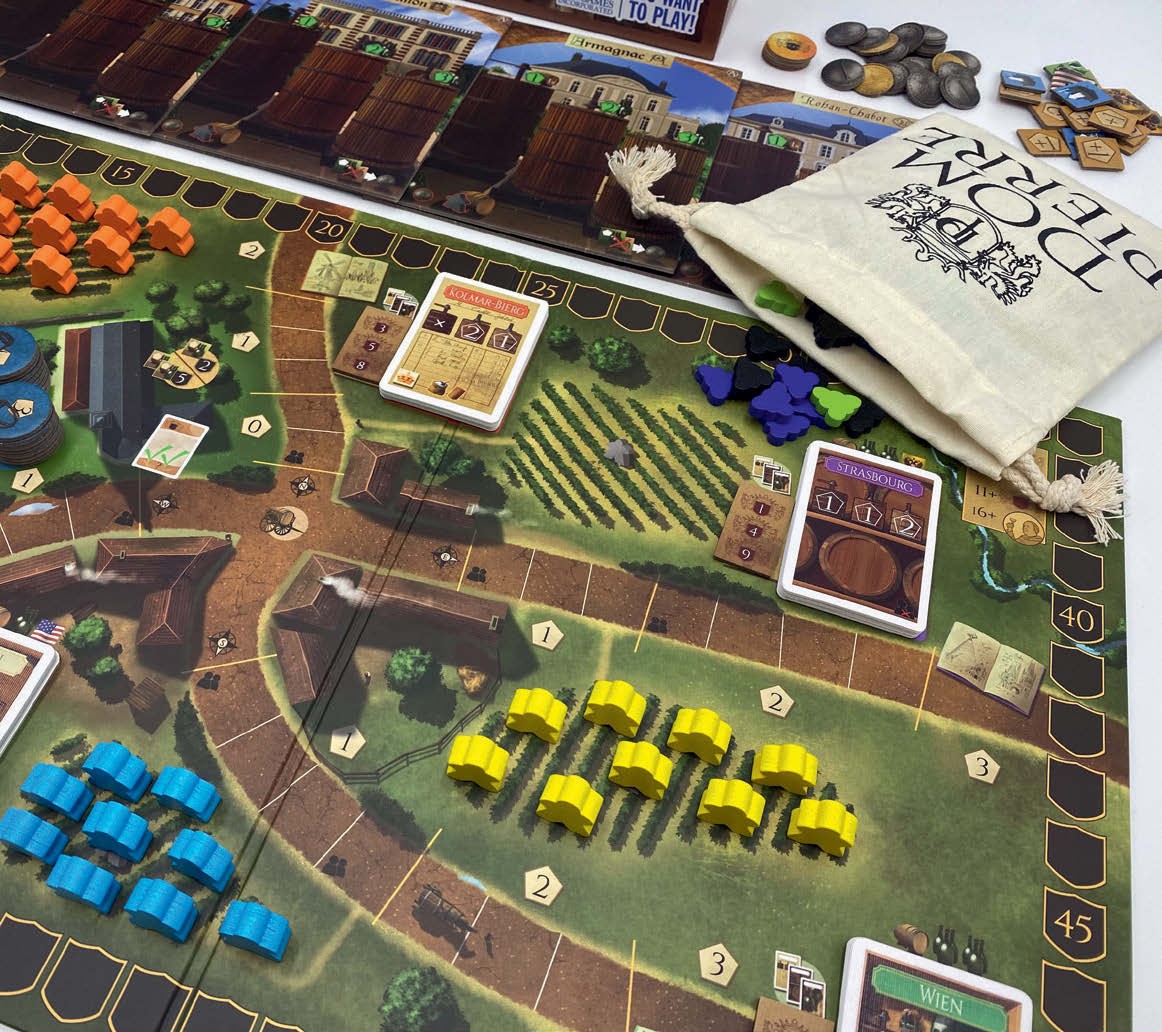No pagne no gain
DOM PIERRE
Designer: Rola & Costa | Publisher: Pile Up Games
I’m going to address the elephant in the room and clarify early on that this is a game about making Champagne, not wine, as at first glance Dom Pierre strongly resembles Stonemaier Games’ classic Viticulture, and to a lesser extent, Vital Lacerda’s Vinhos. But when considering these aesthetic, thematic, and even generic similarities, Dom Pierre interestingly opens up musings on how well mechanical innovations can aid such a game in setting itself apart.
Thankfully, Dom Pierre flaunts its differences immediately with a turn structure guided by a unique action selection mechanism. Taking the form of a matrix on each players’ winery board, action selection follows a process of moving one of six discs associated with each action up one step before carrying it out. Where this disc is positioned will ultimately determine how many times that action can be performed, whilst the location of a player’s lowest disc in the matrix determines how much it will cost. Only the first three actions in the matrix actually incur a cost; Vineyard, Cellar, and Village, but as you’d expect they’re crucial. The trick lies in figuring out how best to increase the strength of particular actions whilst holding back on performing certain others to keep costs down.

There’s many routes to success, but the general gameplay loop prioritises first gathering grapes – either harvested direct from the fields or purchased from the village – pressing them into bottles or barrels, and then selling to one of four markets. How efficiently this is done depends on both the timing of these actions as well as how players supplement them with actions boosting the appeal of their Champagne. Largely this is achieved through the logistics action, which not only expands players’ workforces but also allows for the redistribution of workers across the vineyards, presses, and trade routes. Workers in the vineyard, for example, increase the quality of grapes harvested, whilst those gathered along trade routes boost sale values depending on how far along they are, as well as collecting precious francs upon the workers’ removal.
A savvy, constant awareness of the demands of each market and the various available goal cards is essential and managed in a way that maintains player engagement. Aside from potentially offering some short time goals or strategic guidance, goal cards can also be snapped up by observant players to net quick points based on their current circumstances. The ever-shifting market cards will also reward careful planning as each one details whether bottles or barrels are required alongside bonuses when supplying from particular presses. As the game progresses, the importance of the action selection system is rendered increasingly clear upon the realisation of how scarce money is. Admittedly, Champagne wasn’t popular – and consequently, lucrative – until the 18th century. Thus, in keeping with this history, players in Dom Pierre are competing for prestige rather than coin. What results is a game that feels consistently tight and restrictive; qualities that players will either embrace or bounce off of depending on their gaming preferences. Personally, whilst the pervasive feeling of never having enough money felt depressingly apposite, this tight design invitingly beckons you to figure it out. On the other hand, the looming threat of analysis paralysis is likely to rear its head even at early stages of the game.
Regardless of tastes, it’s hard to deny the exquisitely orchestrated balance and cleverness of Dom Pierre’s tightly interwoven mechanics and potentially punishing gameplay. It’s certainly a far cry from Viticulture’s relative accessibility, so players looking for a more serious venture should find plenty to wet their whistle here.
CHAD WILKINSON
WHAT’S IN THE BOX?
◗ Game board
◗4 Player boards
◗ Prestige board
◗51 Grapes
◗ Cloth bag
◗24 Action discs
◗8 Scoring markers
◗36 Workers
◗45 Harvest tiles
◗40 Champagne tiles
◗32 Accessory tokens
◗16 Prestige tokens
◗49 Goal cards
◗12 Vintage tokens
◗18 Modifier tokens
◗5 Ratio tiles
◗28 Coins
◗60 Market cards
◗2 Information sheets
TRY THIS IF YOU LIKED VITICULTURE
A more refined and full-bodied approach to the theme.